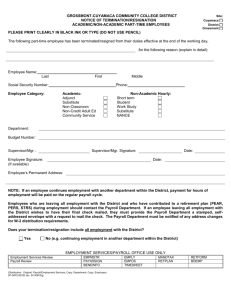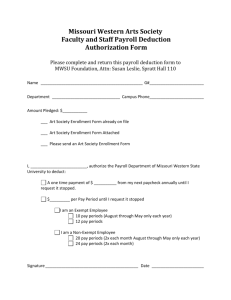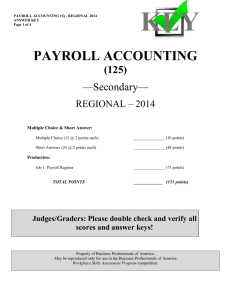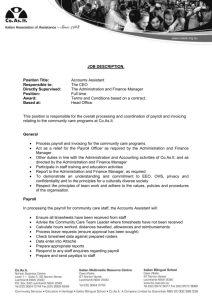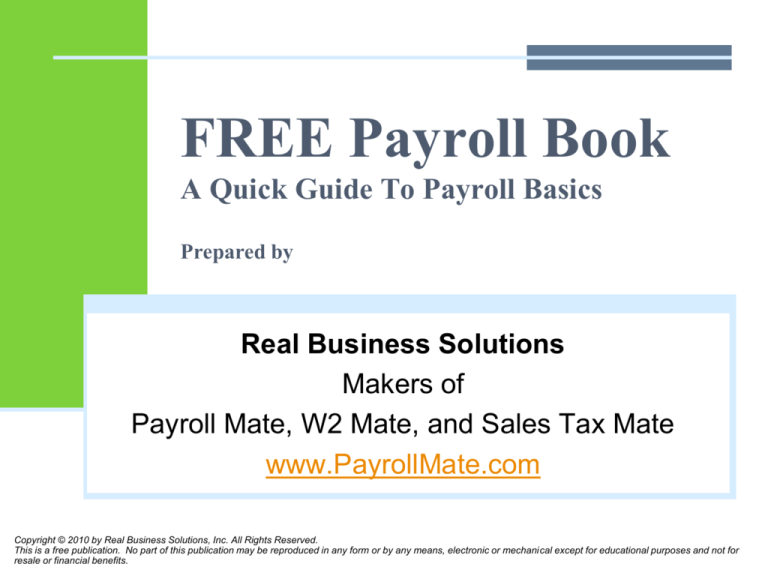
FREE Payroll Book
A Quick Guide To Payroll Basics
Prepared by
Real Business Solutions
Makers of
Payroll Mate, W2 Mate, and Sales Tax Mate
www.PayrollMate.com
Copyright © 2010 by Real Business Solutions, Inc. All Rights Reserved.
This is a free publication. No part of this publication may be reproduced in any form or by any means, electronic or mechanical except for educational purposes and not for
resale or financial benefits.
Table of contents
Part one
About Real Business Solutions
Introduction and History of Payroll and Payroll Taxes
Terminology
Methods of Payroll Preparation
Payroll Processing Steps
Why Buy Payroll Software and Prepare Payroll in House?
How to Choose the Right in House Payroll Preparation Software
Part Two
If You are Responsible for Running Payroll for Your Entity What Do You Need To Do?
You Have a New Employee What Now?
Minimum Wage Requirements
Employees Time Tracking
Time to Prepare Payroll
Direct Deposit
Year End Payroll Requirement
Payroll Preparation - Good Habits For In House Software Users
Helpful Websites
Preface
It is quite clear that there is no a shortage in books and manuals when it comes
to payroll as it is an important subject for almost any business. However most of
those manuals and books are written by accountants for accountants.
This FREE payroll E-Book guide is an attempt intended to help introduce small
business owners and small business managers to payroll concepts and methods
to help them better track their payroll as well as make the right decisions to
choose the appropriate methods and practices, and also shed some light on
major payroll questions. This guide is not intended for tax professionals or
professional payroll managers, who mostly refer to more detailed manuals.
This quick guide also offers a basic payroll preparation model using common
payroll preparation practices and not intended to offer any legal or tax advice as
there are several laws and regulations the employer or the employee could be
subject to depending on the subject matter and the circumstances.
We strongly recommend that the user seeks tax and legal advice as well as
contact the proper Federal, State and local agencies to determine what are his
or her legal and financial obligations.
FREE Payroll Books by www.PayrollMate.com
Part 1
FREE Payroll Books by www.PayrollMate.com
About Real Business Solutions
Real Business Solutions is an industry leader in providing solutions for
businesses and tax professionals, and prides itself on providing some of the
best technical support in the industry.
Real Business has three published products:
Payroll Mate: Comprehensive payroll software that fits the needs of accountants, small and medium
size businesses. Payroll Mate automatically calculates net pay, federal withholding tax, Social
Security tax, Medicare, state and local payroll taxes. Payroll Mate also supports different types of
payroll pay periods, prints checks, prepares payroll forms 941, 944, 940, W2 and W3. Payroll Mate
software also supports user-defined income, tax, and deduction categories, making it very flexible and
powerful with the ability to add on options like direct deposit capability, generate W2 forms on blank
paper, and MICR checks. Payroll Mate can also generate forms California DE-6, California DE-7,
Texas C-3, Texas C-4, New York NYS-45, Illinois IL-941 and Illinois UI-3/40. Payroll Mate exports
payroll data to QuickBooks, Quicken and other accounting software like Microsoft Office Accounting.
W2 Mate Software: Simple yet sophisticated W2 1099 software, used to prepare, import, e-file and
print W2 and 1099 forms. W2 Mate offers the ability to print on preprinted tax forms and on blank
paper. W2 Mate supports 1099-MISC, 1099-INT, 1099-DIV, 1099-R, 1096, W-2, W-3. W2 Mate can
import data from QuickBooks, Microsoft Dynamics GP, MAS 90 and MAS 200 and other accounting
software.
Sales Tax Mate: Powerful, yet user friendly software, used to prepare Illinois sales tax returns and
generate sales tax forms on blank paper ready to be filed with Illinois Department of Revenue.
FREE Payroll Books by www.PayrollMate.com
Introduction and History of Payroll
Taxes
Payroll has evolved over time from its humble beginnings of just tracking hours worked by
employees, paying employees and maintaining the proper records into a profession that
employs thousands of professionals and handles a wide range of duties that naturally
includes tracking employees (hours worked, vacation time, sick time), withholding taxes,
reporting wages and submitting different reports to various government and non-government
agencies utilizing the advancements in technology, including computer software, time
tracking equipment and remotely hosted applications.
In modern time the true start of payroll tax occurred with the passage of the Revenue Act in
1861 which introduced a 3% withholding on all incomes of $800.00 per year. Another
landmark was the introduction of the Social Security Act in 1935, which comprised of a two
percent tax: One percent paid by the employer and one percent deducted from the
employee’s paycheck. Over time payroll taxes were amended and changed repeatedly.
Currently the following payroll taxes are applicable:
Federal Withholding Payroll tax which includes Social Security and Medicare taxes.
Federal Unemployment tax.
State Withholding Payroll tax (not applicable in all states).
State Unemployment tax or something similar depending on individual states.
Local taxes. (City or County taxes for example).
FREE Payroll Books by www.PayrollMate.com
Terminology
Payroll: Payroll is all the financial records and data related to salaries, wages, overtime, bonuses, deductions, withholdings,
garnishments related to the entities, employees, owners or partners paid for services provided during a specific period of time.
Employee: In this guide the term employee strictly means a W2 recipient regardless of how he or she is defined under various
statues.
W-2 Form: An official Internal Revenue Service tax form used by the employers (regardless of whether they are tax exempt or
not) to report wages paid by employers to their employees and taxes withheld in accordance with the applicable tax code for the
particular tax year. It may also include other deductions such as health insurance, 401K and other related items. Employers are
required under the law to file the W2 forms with Social Security Administration before the deadline in place every year.
W-3 Form: An official Internal Revenue Service tax form used by the employers (regardless of whether they are tax exempt or
not) that summarizes most of the data reported on individual W2 forms. Currently each employer files one W3 (regardless of the
number of W2 forms filed) along with the W2 forms filed with the Social Security before the deadline every year.
W-4 Form: An official Internal Revenue Service tax form used by the employers, prepared and signed by the employees to collect
vital tax data from employees like :their filing status and number of allowances, to help the employer withhold the accurate
amount of Federal taxes from employees earnings as required by the applicable tax laws. Employers should keep a signed copy
on file for each employee, and are encouraged to update the form annually, or when changes in the number of allowances occur.
941 Form: An official Internal Revenue Service tax form used by the employers (regardless of whether they are tax exempt or
not). The form summarizes wages paid, Federal payroll taxes withheld, Social Security taxes, Medicare taxes, and other related
payments and withholdings to the Internal Revenue Service at the end of every quarter.
940 Form: An official Internal Revenue Service tax form used by the employers that summarizes wages paid and Federal
Unemployment Taxes accrued on wages subject to Federal Unemployment Tax (FUTA) for the entire tax year. The form is filed
annually before the official deadline.
944 Form: An official Internal Revenue Service tax form used by the employers (regardless of whether they are tax exempt or
not) that summarizes wages paid, Federal payroll taxes withheld, Social Security taxes, Medicare taxes, and other related
payments and withholdings to the Internal Revenue Service at the end of every year (mostly used by smaller employers).
FREE Payroll Books by www.PayrollMate.com
Terminology (cont’d)
What is Payroll : Payroll is all the financial records and data related to salaries, wages, overtime, bonuses, deductions,
withholdings, garnishments related to the entities, employees, owners or partners paid for services provided during a specific
period of time.
Employee: There are various definitions for who is an employee. One of the definitions for an employee is the common law
definition (an employee is a person who performs services for an employer who has the right to control and direct the results of
the work and the way in which it is done). In this guide the term employee strictly means a W2 recipient regardless of how he or
she is defined under various statues.
W-2 Form: An official Internal Revenue Service tax form used by the employers (regardless of whether they are tax exempt or
not) to report wages paid by employers to their employees and taxes withheld in accordance with the applicable tax code for that
particular tax year. It may also include other deductions such as health insurance, 401K and other related items. Employers are
required under the law to file the W2 forms with Social Security Administration before the deadline in place every year.
W-3 Form: An official Internal Revenue Service tax form used by the employers (regardless of whether they are tax exempt or
not) that summarizes most of the data reported on individual W2 forms. Currently each employer files one W3 (regardless of the
number of W2 forms filed) along with the W2 forms filed with the Social Security before the deadline every year.
W-4 Form: An official Internal Revenue Service tax form used by the employers yet prepared and signed by the employees to
collect vital tax data from employees like (their filing status and number of allowances) to help the employer withhold the accurate
amount of Federal taxes from employees earnings as required by the applicable tax laws. Employers should keep a signed copy
on file for each employee and are encouraged to update the form annually or when changes in the number of allowances occur.
941 Form: An official Internal Revenue Service tax form used by the employers (regardless of whether they are tax exempt or
not) that summarizes wages paid, Federal payroll taxes withheld, Social Security taxes, Medicare taxes, and other related
payments and withholdings to the Internal Revenue Service at the end of every quarter.
940 Form: An official Internal Revenue Service tax form used by the employers that summarizes wages paid and Federal
Unemployment Taxes accrued on wages subject to Federal Unemployment Tax (FUTA) for the entire tax year. The form is filed
annually before the official deadline.
944 Form: An official Internal Revenue Service tax form used by the employers (regardless of whether they are tax exempt or
not) that summarizes wages paid, Federal payroll taxes withheld, Social Security taxes, Medicare taxes, and other related
payments and withholdings to the Internal Revenue Service at the end of every year (mostly used by smaller employers).
FREE Payroll Books by www.PayrollMate.com
Methods of Payroll Preparation
Following are the most popular methods for payroll preparation:
Full outsourcing: (use full payroll preparation provider)
Using an online system or actually calling and speaking with a live
customer service representative.
Typically in this method the employer reports the hours worked, any
overtime, any new hire, status changes garnishments or any special
payroll requirement. The payroll preparation company then creates the
payroll checks and delivers them to the employer whether signed or not
depending on how the payroll service was setup with the company. The
payroll company will also remit the related tax liabilities to the proper
parties. This method entails little work on the employer’s side as he will
mainly handle the office related paperwork, like tracking the workers
hours, files and vacation time.
This method costs several times the cost of in-house payroll preparation
and is popular with small employers with little payroll background
knowledge.
Assisted in house preparation: Contact a tax professional, typically
your accountant, and decide with him or her on a method to handle
payroll which in most cases means he or she will handle the reporting
part and have you (the employer) make the payroll tax payments, and
prepare the payroll checks in house, with the tax professional guidance
either using some payroll preparation software or processing payroll
entirely manually.
This method is also popular with small businesses with some accounting
or payroll background experience and generally costs less than
outsourcing the entire payroll process.
Manual: Prepare the payroll manually and handle the payroll tax
payments and reporting requirements in house. This will entail issuing the
payroll checks in house and handling the reporting requirements
manually. Businesses use this method if they have a limited number of
employees and the owner or manager has a strong payroll background.
Of course this method will cost little to setup as there is very little upfront
spending. However, this method will cost a lot of time and possibly money
as a result calculation errors.
Assisted Online Method: Subscribe to online payroll
preparation software where the software and data are both
remotely hosted by the software company so there is nothing to
install locally on your machine (the user pays a monthly
subscription fee typically based on the number of employees
covered and the frequency of payroll checks.) Payroll data is
typically remotely hosted at the service provider’s servers and
that requires live internet access any time payroll is prepared, or
to access reports or forms. This method typically costs more than
buying software and preparing payroll in house, but costs less
than full outsourcing.
In house payroll software: Buying payroll preparation software
and using it to prepare payroll.
In this method the employer is responsible for data input, printing
checks, remitting taxes withheld to the proper agencies, filling tax
forms and other related reports. This method is efficient and
economical as it typically cost way less than all methods except
for the full manual method, and as technology improves it is
becoming a popular way. It eliminates calculation errors as the
software automatically calculates tax withholdings, and tracks all
defined garnishments and deductions. It also means keeping
good track of payroll data. It is definitely much faster than the
manual method, and it gives the user great control over payroll
data and ability to prepare payroll instantly when compared with
using a payroll preparation company where the turnaround time
between reporting the payroll, or inputting the data online and
receiving the checks could be 24 hours or more.
FREE Payroll Books by www.PayrollMate.com
Payroll Processing Steps
1. Tracking employees hours worked especially for hourly
employees to make sure they work the right number of hours as
planned and track any overtime hours worked to properly
compensate the employees in accordance with the applicable
laws and the company’s policies.
Normally this is accomplished by using some form of time
cards: electronic or manual.
2. The actual preparation of payroll checks including the
calculation of all related withholdings, garnishments, printing
checks and handing them out to employees.
3. Remitting the related tax liabilities , related paperwork and
forms to the proper parties: government or non-government
related agencies.
FREE Payroll Books by www.PayrollMate.com
Why buy software and prepare
payroll in house?
As mentioned earlier there are at least four common methods to prepare payroll, and
each of these methods has its pros and cons
Typically using either method depends on the specific circumstances for each entity
including the availability of skilled staff, company size, number of employees, payroll
frequency, level of control the entity desires to have on its payroll data.
Here are some of the advantages of using in house software method over the rest of
the payroll preparation methods:
1. It is the least expensive method next to the full manual preparation method.
2. It gives the employer great control over the payroll data as the data is stored
locally its more secure and can by accessed any time without the need to go
online.
3. It gives the user the ability to prepare payroll any time compared to outsourcing
where the turnaround time is about twenty four hours or more.
4. It eliminates the calculation errors compared to using the manual method.
5. It is effective for almost any size of business.
FREE Payroll Books by www.PayrollMate.com
How to choose the right in house
payroll preparation software?
Once you have decided to use the in-house payroll preparation
method the first and most important step would be to find the
right software that best fits your needs within your budget.
Obviously, if you have an open budget to spend on buying
payroll preparation software, you can buy the most expensive
package in the market with all the added features that can come
with it assuming that this package will cover all your needs to
prepare your payroll. The reality is that even Fortune 500
companies have a set budget on how much to spend on buying
software, let alone the fact that not every company needs all the
features that could be added to software packages. The trick
here is to buy the software that costs the least and best
serves your needs.
FREE Payroll Books by www.PayrollMate.com
Basic features of a good payroll
preparation software:
A good payroll preparation software should be:
Easy to install on your machine.
Easy to use and navigate around.
Easy to setup your company and employees data and make future changes.
Ability to handle the number of employees you expect to process payroll for, while having room for future
growth and expansion.
Easy to update through internet access.
Easy to back up and restore your data.
Capable of generating Federal quarterly and year-end forms, and preferably state forms too.
Providing decent technical support.
Able to be customized to better fit your needs.
Able to print either on preprinted check stock or on blank check stock.
Able to generate reports or data to export, or book into your general ledger software.
Able to generate direct deposit files (ACH).
Able to generate a wide range of reports that can serve your needs like amount required to make a payroll
tax deposit.
Supporting updates, changes in tax tables and forms that are covered during the tax year.
Offering annual updates at a reasonable price.
FREE Payroll Books by www.PayrollMate.com
Part 2
FREE Payroll Books by www.PayrollMate.com
If you are responsible for running payroll
for your entity what do you need to do?
Contact the INTERNAL REVENUE SERVICE , the local and
state tax authorities to inquire about the registration
requirements, reporting requirements, record keeping
requirements, tax withholding requirements, payroll tax payment
requirements and any other compliance requirements.
Educate yourself about payroll tax and payroll preparation
methods.
Refer to Publication 15, better known as (Circular E). It has
a wealth of information. You can access the publication
free from the official IRS website at www.irs.gov
Decide on what method to use to prepare payroll based on
your needs, skills and the size of your payroll.
FREE Payroll Books by www.PayrollMate.com
You have a new employee what
now?
Once you have a new hire and you have both agreed on the pay scale,
job description and other related issues, you should create a new file
for that employee and that file typically contains at least the following
items:
1. Job application.
2. Employee resume.
3. Copies of proper identification cards.
4. Signed W-4 and the equivalent of a state W-4.
5. Information related to wage garnishments and deductions.
6. All leaves or vacation requests.
7. All employee reviews, thank you letters, or any formal
communications with the employee.
8. Resignation letter or anything similar after the employee leaves.
FREE Payroll Books by www.PayrollMate.com
Minimum Wage Requirements
The U.S Department of Labor mandates that
employers pay their employees covered under the
law the minimum wage published by the department
or higher. Also some states mandate minimum wage
requirements. In cases where the employee is
subject to both federal and state minimum wage
requirements, the employee is entitled to receive the
higher of the two minimum wages.
You can contact your State Department of Labor
or U.S Department of Labor for more information
about this topic.
FREE Payroll Books by www.PayrollMate.com
Employees Time Tracking
In general there should be a method for tracking: when every
employee punches in and out of work, and track lunch breaks and the
time off taken during the working day.
As for hourly paid employees, maintaining time cards is part of the
payroll preparation process to account for hours worked and any
overtime if applicable.
The two most popular methods for time tracking are:
1. Manual punch cards. The employee punches the card as he/she
starts his/her work and punches out when he/she leaves.
2. Electronic time tracking could be as simple as swiping a magnetic
card in a machine or as sophisticated as a thumb identification sign in,
sign out method.
Regardless of the method used, it is important to remember that the
primary purpose of tracking employees time is to prepare payroll and
cut pay checks.
FREE Payroll Books by www.PayrollMate.com
Time to prepare payroll using your in
house payroll preparation software
Now that you have hired employees ,started a file for each one
of them, implemented a system to track their time at work,
purchased payroll software and installed it on your computer,
you are ready to prepare your first payroll.
Generally this comprises of three steps:
Step one
Setup your company data and employees data inside the software
Step two
Process actual live payroll
Step three
Remit taxes and file forms and reports
FREE Payroll Books by www.PayrollMate.com
Prepare Your First Payroll
Step One
Setup your company data and employees data inside the
software
1.
2.
3.
Make sure you setup your company information inside the in-house payroll software you have
purchased and installed on your computer.
Setup all the employees inside the payroll software, make sure you pay attention to all the details
and never overlook any step, box or check mark.
Setup the employees basic info such as name, address, social security number and contact
information.
4.
Pay special attention to employees pay frequency as this in most cases tells the software how to
calculate the tax withholding amounts.
Pay special attention to the tax withholding setup in regards to filling status, number of exemptions,
any additional withholdings the employee asked for.
All data should be taken from the W-4 signed earlier by the employee.
Pay special attention to deductions and garnishments setup as to whether they are pre-tax or after tax
deductions.
Pay special attention to the regular hourly pay setup and overtime pay setup.
Run a sample payroll for every employee and make sure the software tracks and calculates data
as intended. Run some reports and perhaps the 941 form and review all the details. You could
contact your tax professional and ask him/her to review the output to make sure you have setup
your employees correctly, and make any changes if necessary. (Make sure you delete all the
dummy checks you have created inside your payroll software).
Prepare Your First Payroll
Step Two
Process actual live payroll
Now that you have finished your employees and company setup properly you can
start your first payroll.
1.
2.
3.
4.
5.
6.
7.
To run a real payroll, start by collecting your employees time cards and calculating hours
worked by each one.
Pay attention to overtime or any special requests.
Prepare paychecks for your salaried employees, first then print the checks and review them.
Prepare paychecks for hourly employees, then print the checks and review them.
Remove the one check stub from each paycheck you have prepared and attach them to
time sheets for this particular pay period. (Typically each paycheck sheet contains two pay
stubs).
Run a detailed report for this pay period and keep it for your records.
Make sure you back up your data into a portable device like a flash drive or something
similar and keep it in a safe and handy place.
FREE Payroll Books by www.PayrollMate.com
Prepare Your First Payroll
Step Three
Remit taxes and file forms and reports
1.
2.
3.
4.
Remit taxes withheld to the appropriate tax authorities and that typically includes federal, state
and maybe local taxes. Normally the frequency of tax remittance depends on the amount
withheld, and the tax authorities instructions. Therefore it is important to know ahead of time
where and when to remit taxes withheld.
Remit any deductions such as 401k or similar deductions to the proper party.
Remit any garnishments such as child support to the proper authorities.
File the required reports or tax forms with the appropriate authority, that includes quarterly 941
form or similar state or local form, or other authorities.
FREE Payroll Books by www.PayrollMate.com
Direct Deposit
Direct deposit generally refers to the process of depositing the
employees net pay check directly into their bank account known
otherwise as ACH (Automated Clearing House) method.
Benefits of using this method include:
1. Confidentiality, as the number of people who handle a paycheck is
about three times the number of people who handle the direct deposit.
2. Reduction of fraud, for example forged signature and stolen checks.
3. Saving paper and envelopes (go green).
4. Ensuring (in most cases) timely deposit of funds into employees bank
accounts.
5. Saving the employees the leg work of going to the bank to deposit or
cash the checks (go green).
6. Ensuring the employee gets paid timely if he/she was off or on
vacation at pay day, without having go to work just to pick up the check
or have the check mailed (go green).
FREE Payroll Books by www.PayrollMate.com
Direct Deposit (cont’d)
It is important to remember, however, that the employer has to give the employees the
choice between the direct deposit method and the actual paper check as some employees
don’t have bank accounts. If you decide to offer your employees the direct deposit method,
make sure you have your employees fill out and sign the direct deposit authorization form
which typically contains:
1.
Employee’s first and last name
2.
Employee’s address.
3.
Employee’s financial institution name.
4.
Employee’s financial institution account number.
5.
Employee’s financial institution routing number.
6.
Account type whether it is savings or checking account.
7.
Account ownership, is it self or joint or other.
8.
Date direct deposit becomes effective.
9.
A paragraph authorizing the employer to deposit funds in the account and reverse the
deposit or a portion if there were deposit errors.
10. Employee’s signature and date the form was completed.
11. In most cases your financial institution can help or direct you as to where you can
obtain direct deposit authorization forms.
FREE Payroll Books by www.PayrollMate.com
Year end Payroll requirements
Following are some of the requirements employers need to
comply with:
1. File the year end 940 Federal Unemployment tax form
(some tax exempt organizations are not required to file this
form) check with your tax advisor or the Internal Revenue
Service to learn more about this subject.
2. Prepare W2 forms and furnish them to the employees
before the deadline (currently the deadline is January 31st
of the year following the subject year.)
3. File W2 forms with the Social Security Administration, the
two most popular methods used are: E-filing and filing the
actual forms.
FREE Payroll Books by www.PayrollMate.com
Payroll preparation good habits for
in house software users
1.
2.
3.
4.
5.
6.
7.
8.
9.
10.
11.
12.
13.
Try to make payroll frequency as least as possible to eliminate errors.
Be consistent and try to follow the same steps every time you prepare payroll to eliminate errors.
For example if you start by preparing payroll for salaried employees, always start by preparing
payroll for salaried employees.
If you have to prepare payroll for a big number of employees, divide them into batches print them
and review them before you proceed to the second batch.
Have a check list for preparing payroll and mark off the steps you completed as you progress.
Prepare payroll ahead of time and don’t wait until the last minute.
Always update employees data as you get it and don’t wait till you prepare payroll.
Always review employees hours and compare them to their schedule. Look for overtime or out of
the ordinary hours.
Avoid making exceptions for employees as they might ask for favors such as receiving payroll
checks one or two days ahead of time, or an advance on the next payroll check.
Back up your data every time you prepare payroll to an external drive ( flash or something similar).
Keep hard copies for check stubs for all checks prepared.
Maintain a separate file for each tax year and keep hard copies of all forms and reports filed and
notices received.
Setup a password on your payroll software and share it with only one trusted person.
Limit the number of people who access the computer where you store your payroll and business
data.
FREE Payroll Books by www.PayrollMate.com
Helpful Websites
Official IRS website www.irs.gov
Official Social Security website www.ssa.gov
Official U.S Department of Labor website www.dol.gov
Official U.S Small Business Administration website www.sba.gov
Payroll Software for Small Business & Tax Professionals www.PayrollMate.com
Payroll Taxes for Major US Cities www.Payroll-Tax.Realtaxtools.com
American Payroll Association www.AmericanPayroll.org
Payroll Forms, Payroll Checks and Tax Supplies www.FormsMall.com
FREE Payroll Books by www.PayrollMate.com


